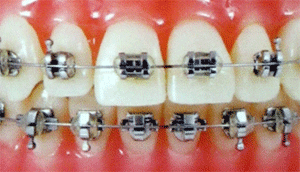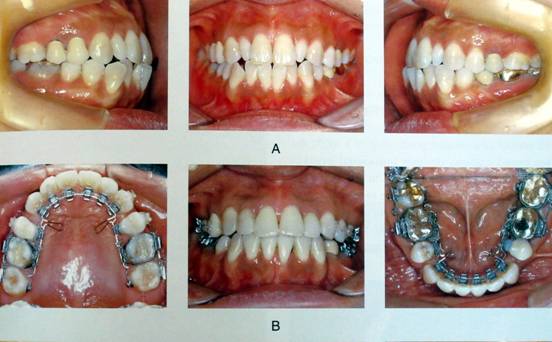Dental Implants
Dental implants are used to attach artificial replacement teeth firmly to the bone. Implants can support a single crown, which replaces a lost tooth, or they can serve as anchors for fixed bridges which would replace several missing teeth. Implants can also act as anchors for a removable partial or complete denture.

Restoring Naturally Beautyful, Confident Smiles
Dental Implants offer a solution to missing teeth that is intended to be permanent. For over 30 years, dental implants have brought naturally beautiful, confident smiles to patients. A dental implants is a small titanium screw or cylinder which is surgically placed in the upper or lower jawbone. The implant replaces the root of the missing tooth, providing an anchor for your new tooth/teeth. Many patients choose dental implants over other procedures, because the result is a natural appearance, that is intended to be permanent.
Dental implants have brought naturally beautiful, confident smiles to patients for over 30 years.
Restoring naturally beautiful, confident smiles means more than just restoring teeth; it means restoring and improving your quality of life. With implants, chewing and speech problems caused by missing teeth may be restored or improved and a natural appearance may allow you to enjoy your favorite foods and have the confidence you desire for an active professional and social life.
Implants dentistry is the most advanced therapy available to replace teeth. In addition to looking and feeling like real teeth, dental implants may allow you to:
- Improve your smile
- Eat the foods you enjoy
- Restore chewing for easy digestion
- Speak with greater ease
- Restore your facial structure
- Enjoy an active lifestyle
- Live with confidence




Dental implants offer solutions for all types of tooth replacements.
Single Tooth And Multiple Tooth Replacement Dental implants replace the tooth root and serve as an anchor, your new tooth/teeth are secured directly on the implant. This treathment allows teeth to be restored naturally, without harming or involving your surounding teeth.
Small metal posts are connected to the implants, allowing the replacement Small metal posts are connected to the implants, allowing the replacement
Implants-Supported Dentures Dental implants can also be placed to anchor and support partial of full dentures, eliminating the need for dental adhesives. Enjoy having the confidence to eat the foods you previously avoided.
Dentures can be supported with either a bar/clip or ball/socket attachment for removal, allowing for regular cleaning.
Traditional procedures
- Other Options Damage Healthy Teeth
Other options, such as traditional crown and bridge procedures, may involve cutting down healthy adjacent teeth to anchor the restoration.
- Other Options are Uncomfortable
Appliances that require adhesives may be uncomfortable when eating. In additional, metal clasps may be visible, resulting in poor aesthetics.

Dentist will perform a complete examination involving X-Rays to determine if implants are right for you. Once your specific needs are assesed, your doctor will schedule an appointment for you to come in for a consultation. Together, you will discuss your options and decide which treatment plan is best for you. Depending on your needs, your treatment may be completed in three steps.
- The Surgeon places an OSSEOTITE implants into your jawbone. The implant replaces the natural tooth root and provides structural support.
- The Restoring Doctor will make models of your mouth. The models will be sent to the laboratory to create your replacement tooth/teeth.
- The Restoring Doctor will attach your replacement tooth/teeth. The result may be the look and feel of natural teeth. Chewing and speech may be restored or improved, while bone structure is preserved.
Brite Smile Teeth whitening

Over 1.4 Million Satisfied Customers
BriteSmile is the world leader in smile solutions. Using the most advanced technology, our BriteSmile Dentists can take years off your look and give you the perfect bright smile you have always dreamed of. BriteSmile offers Lumineers®, to permanently correct misaligned, chipped or stained teeth; Invisalign®, the invisible way to straighten your teeth without braces at any age; and a One Hour Teeth Whitening treatment for a dazzling, white smile
How BriteSmile works?
BriteSmile’s teeth whitening system composes of the gentle whitening gel and the specially designed blue-light technology. The whole whitening process takes only 1 hour and customers do not need to continue it with a take-home whitening tray. The Blue Light, a BriteSmile’s patented technology, is not a UV, nor a heat, nor a laser, but a gentle light that works in tandem with our whitening gel to accelerate the whitening process, whitening teeth up to 10 shades of dental whiteness with the average of 9 shades, giving you the total confidence to a white bright smile.
The BriteSmile’s Whitening Gel
The BriteSmile’s proprietary Whitening Gel contains only 15% peroxide optimized for patient safety and maximum result while other whitening gels contain as much a 35% or more of the hydrogen peroxide.
A New Smile in just 1 Hour
BriteSmile is overseen with trained dentists and dental professionals to ensure you with total safety.
- 98% of customers are satisfied with BriteSmile’s whitening service
- 95% did not experience temporary tooth sensitivity
- 98% are more confident in their bright and brilliant smiling

Confident with Total Safety
Studies conducted by the US University of Medicine and Dentistry of New Jersey and confirmed by senior researchers at NYU, prove the BriteSmile Professional Teeth Whitening Treatment is safe without any harm to tooth enamel, composite materials or dentures.
This highest safety comes from BritSmile’s proprietary whitening gel buffered to a near-neutral pH value that is gentle to the gum. Also, this gel is applicable only at the teeth without the needs to swallow it into other products available in the market.
For all Occasions in Life
Treat yourself a BriteSmile treatment for brilliant looking bright smile or give the service as a gift to your loved one in their special occasions, whether it be birthday, wedding day, graduate day or even Mother’s and Father’s days.
BriteSmile… Makes you smile
A bright smile with brilliant white teeth is an inspiration for you to happily smile to those around you. Why wait, if today BriteSmile teeth Whitening system from Hollywood can effectively whiten your dull, stained teeth caused by aging and lifestyle such as smoking or drinking coffee, tea and wine. With BriteSmile’s globally accepted breakthrough technology combined with dentistry’s preciseness and delicacy proved safe and effective. The treatment is very popular in fashion circles and beauty institutes around the world for being able to ‘whiten your teeth’ effectively in just 1 hour.

BriteSmile Teeth Whitening Products
Since we know that having bright white teeth help creating impressively brilliant smile, BriteSmile has an array of teeth whitening products available for you. Just brush your teeth with BriteSmile-patented whitening Toothpaste and keep your bright glistening smile by rinsing your teeth with BriteSmile proprietary gentle Mount Rinse that will keep your bright smile a long-lasting result. Also, there is BriteSmile-to-Go Pen applicator that conveniently delivers teeth whitening anywhere anytime.
Porcelain Crowns and Porcelain fuse to metal crowns What are crowns?
Dental crown is a tooth-shaped “cap” that is placed over a tooth—covering the tooth to restore its shape and size, strength, and/or to improve its appearance.
The crowns, when cemented into place, fully encase the entire visible portion of a tooth that lies at and above the gum line.
Why Is a Dental Crown Needed?
A dental crown may be needed in the following situations:
- To protect a weak tooth (for instance, from decay) from breaking or to hold together parts of a cracked tooth
- To restore an already broken tooth or a tooth that has been severely worn down
- To cover and support a tooth with a large filling when there isn’t a lot of tooth left
- To hold a dental bridge in place
- To cover misshaped or severely discolored teeth
- To cover a dental implant
Permanent crowns can be made from all metal, porcelain-fused-to-metal, or all ceramic
- Metals used in crowns include gold alloy, other alloys (for example, palladium) or a base-metal alloy (for example, nickel or chromium). Compared with other crown types, less tooth structure needs to be removed with metal crowns, and tooth wear to opposing teeth is kept to a minimum. Metal crowns withstand biting and chewing forces well and probably last the longest in terms of wear down. Also, they rarely chip or break. The metallic color is the main drawback. Metal crowns are a good choice for out-of-sight molars.
- Porcelain-fused-to-metal dental crowns can be color matched to your adjacent teeth (unlike the metallic crowns). However, more wearing to the opposing teeth occurs with this crown type compared with metal crowns. The crown’s porcelain portion can also chip or break off. Next to all-ceramic crowns, porcelain-fused-to-metal crowns look most like normal teeth. However, sometimes the metal underlying the crown’s porcelain can show through as a dark line, especially at the gum line and even more so if your gums recede. These crowns can be a good choice for front or back teeth.
- All-ceramic or all-porcelain dental crowns provide the best natural color match than any other crown type and may be more suitable for people with metal allergies. However, they are not as strong as porcelain-fused-to-metal crowns and they wear down opposing teeth a little more than metal crowns. All-ceramic crowns are a good choice for front teeth.
Porcelain Crowns and Porcelain fuse to metal crowns
What are crowns?
Dental crown is a tooth-shaped “cap” that is placed over a tooth—covering the tooth to restore its shape and size, strength, and/or to improve its appearance.
The crowns, when cemented into place, fully encase the entire visible portion of a tooth that lies at and above the gum line.
Why Is a Dental Crown Needed?
A dental crown may be needed in the following situations:
- To protect a weak tooth (for instance, from decay) from breaking or to hold together parts of a cracked tooth
- To restore an already broken tooth or a tooth that has been severely worn down
- To cover and support a tooth with a large filling when there isn’t a lot of tooth left
- To hold a dental bridge in place
- To cover misshaped or severely discolored teeth
- To cover a dental implant

Permanent crowns can be made from all metal, porcelain-fused-to-metal, or all ceramic
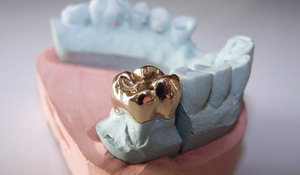
1.Metals
used in crowns include gold alloy, other alloys (for example, palladium) or a base-metal alloy (for example, nickel or chromium). Compared with other crown types, less tooth structure needs to be removed with metal crowns, and tooth wear to opposing teeth is kept to a minimum. Metal crowns withstand biting and chewing forces well and probably last the longest in terms of wear down. Also, they rarely chip or break. The metallic color is the main drawback. Metal crowns are a good choice for out-of-sight molars.
2.Porcelain-fused-to-metal
dental crowns can be color matched to your adjacent teeth (unlike the metallic crowns). However, more wearing to the opposing teeth occurs with this crown type compared with metal crowns. The crown’s porcelain portion can also chip or break off. Next to all-ceramic crowns, porcelain-fused-to-metal crowns look most like normal teeth. However, sometimes the metal underlying the crown’s porcelain can show through as a dark line, especially at the gum line and even more so if your gums recede. These crowns can be a good choice for front or back teeth.
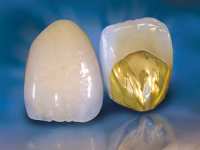
3.All-ceramic or all-porcelain
dental crowns provide the best natural color match than any other crown type and may be more suitable for people with metal allergies. However, they are not as strong as porcelain-fused-to-metal crowns and they wear down opposing teeth a little more than metal crowns. All-ceramic crowns are a good choice for front teeth.
Partial denture
If you have most or all of your teeth missing, we can help you by creating dentures which closely resemble naturalteeth and gums.
Dentures help improve your appearance along with restoring eating and speaking abilities. We can also make immediate dentures for patients who need their front teeth extracted, so that they do not have to be without teeth. For the patients who have been using dentures for a longer period, we can reline their old dentures to make them fit as good as new
Denture & Implant
 |
 |
|
| Before | After |
 |
 |
 |
 |
A removable denture
A removable partial denture is a set of false or replacement teeth. Dentures are either manufactured in a complete set or a partial set, depending on the amount of teeth that need to be replaced. If all of the teeth in a person’s mouth need replacement, a set of complete dentures is required. If a person has some original teeth that do not need replacement, a partial set of dentures is created to fit around the existing teeth.
Removable partial dentures may be attached to the teeth in several different ways, depending on the specific requirements of the wearer. The first type is often known as a temporary or treatment partial denture. A temporary removable partial denture typically consists off prosthetic teeth attached to a plastic or acrylic base. The denture may be attached to the teeth with metal clamps or the base may be designed and shaped to hold the denture in place. They are often used as a temporary means of preserving the oral appearance of the wearer while a longer lasting denture alternative is being manufactured.
 |
 |
 |
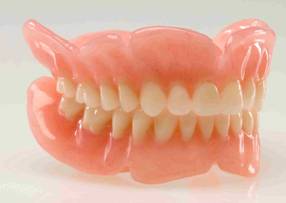 |
A second type of removable partial denture is constructed around a cast metal framework and is often called a cast metal removable partial denture. These types of dentures are designed to be longer-lasting and more comfortable for the wearer than a flipper design. The teeth are attached to a gum-colored acrylic base and are connected through a metal framework that is specifically molded to fit each patient.
 |
 |
 |
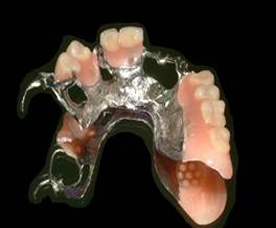 |
Most cast metal removable partial dentures are designed so that the framework does not come into much contact with the gums. This prevents oral sore spots from chafing and rubbing that is commonplace with the temporary partial denture.
 Handling a partial denture requires care. It’s a good idea to stand over a folded towel or a sink of water just in case you accidentally drop the denture. Brush the denture each day to remove food deposits and plaque. Brushing your denture helps prevent the appliance from becoming permanently stained. It’s best to use a brush that is designed for cleaning dentures. A denture brush has bristles that are arranged to fit the shape of the denture. A regular, soft-bristled toothbrush is also acceptable. Avoid using a brush with hard bristles, which can damage the denture.
Handling a partial denture requires care. It’s a good idea to stand over a folded towel or a sink of water just in case you accidentally drop the denture. Brush the denture each day to remove food deposits and plaque. Brushing your denture helps prevent the appliance from becoming permanently stained. It’s best to use a brush that is designed for cleaning dentures. A denture brush has bristles that are arranged to fit the shape of the denture. A regular, soft-bristled toothbrush is also acceptable. Avoid using a brush with hard bristles, which can damage the denture.
Clean your dentures by thoroughly rinsing off loose food particles. Moisten the brush and apply the denture cleaner. Brush all denture surfaces gently to avoid damaging the plastic or bending the attachments.
Denture could lose its proper shape if it is not kept moist. At night, the denture should be placed in soaking solution or water. However, if the appliance has metal attachments, they could be tarnished if placed in soaking solution. Your dentist can recommend the proper method for keeping your dentures in good shape.
Dental Inlay / Onlay
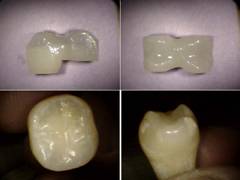
An inlay is an indirect restoration constructed of cast metal, porcelain/ceramic, or composite/resin that neither supports nor replaces a cusp or cusps of tooth. The inlay restoration is nothing more than a centric stop in that it provides no protection for the cusp tip as concerns lateral and/or protrusive masticatory excursionary forces.
An onlay is an indirect restoration (fabricated outside the oral cavity) that covers one or more cusps, extending through and beyond the cusp tip to the facial/lingual and proximal slopes of the covered cusps. It may be fabricated from any of the materials used for inlay restorations. It is implicit in this type of restoration that occlusion in all functional positions is supported by restorative material rather than the tooth structure of the covered cusps.
Dental inlays and onlays are used to repair decaying teeth that do not require extensive bridgework, or to replace older metal fillings. Most dental inlays and onlays are composed of porcelain, though some can be made from gold or composite resin. Patient that desire a natural smile often request porcelain inays and onlays, since they are highly undetectable.
| Before | After |
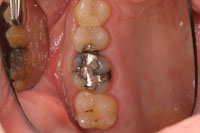 |
 |
 |
 |
Benefits of Dental Inlays and Onlays
In treating dental decay, inlays and onlays help to eliminate tooth sensitivity and eventual tooth loss. Inlays and onlays also offer the following benefits:
- Since they can be made from tooth-colored material, including porcelain and composite resin, inlays and onlays are virtually invisible.
- Unlike metal fillings, inlays and onlays will not expand or contract in response to temperature changes caused by hot or cold foods. This change in size can cause teeth to weaken or fracture.
- The use of inlays and onlays requires less tooth reduction than does the use of metal fillings. This allows dentists to conserve more of a patient’s natural tooth structure in the treatment process.
- Because of the way inlays and onlays are made, they help to strengthen teeth by up to 75 percent.
- The durable material from which inlays and onlays are made helps them last up to 30 years, much longer than that of conventional fillings.
- Inlays and onlays can replace silver fillings to create a healthier, more natural-looking smile.
- By saving decayed teeth, inlays and onlays prevent the need for more extensive treatment later on.
Gold inlay
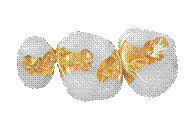 |
 |
Orthodontic treatment

Functional Orthodontics
This treatment is based on removable appliances that stimulate bone and muscle growth and correct the alignment of the teeth.
Fixed or Bonded Orthodontics
This treatment is based on a bonded bracket system with archwires that correct the alignment of the teeth.
Orthodontic treatment can begin at age 5 or 6 with interceptive orthodontics in the form of either functional or fixed appliances. At age 11-15, orthodontics can either perform the removable or bonded therapy, or a combination of both, based on the form and genetic inheritance of the individual. As for adults, orthodontic treatment is centered around a cosmetic approach, utlilzing “invisible” and tooth coloured appliances to coincide with the lifestyle of the individual
 |
 |
 |
 |
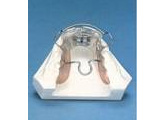 |
Orthodontic Procedure :
|
1. Metal Brace
|
2. Ceramic Braces
|
|
3. Damon System<
|
4. Clarity SL Self-Ligating System
|
|
5.Lingual orthodontics
|
|
 |
 |
|
6. Invisalign® |
|
Alternative Orthodontic Treatment link
- Damon System
- Tooth-Colored Braces
- Invisalign
- Lingual Braces
- Orthognathic Surgery
- Temporary Anchorage Devices / TADs
- Thai Association if Othodontists
| Before The Treatment | |||
 |
 |
 |
 |
| After The Treatment | |||
 |
 |
 |
 |
 |
 |
Full mouth rehabilitation with Porcelain fused to metal crown
Full mouth rehabilitation with Porcelain fused to metal crown By Dr.Tanit Kiatpanabhikul
Case 1
 |
 |
 |
 |
 |
 |
Case 2
Full mouth rehabilitation & multiple dental implant with anterior ceramic and posterior Porcelain fused to metal crown.
 |
 |
 |
 |
 |
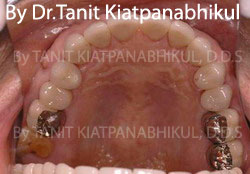 |
 |
 |
Endomicroscope (Innovation in Dental treatment)
Endomicroscope can help by making dental treatment easier and more effective.
Endomicroscope benefits include:
– Locating the entrance to the root canal, otherwise too difficult to treat.
– Surgical implantation in some positions.
– Reduces process and treatment time.
– Reducing the risk of unnecessary dentin scrolling.
– Improved opportunity in treating difficult and complicated cases.
Endomicroscope, is one of the innovations used to up-grade our services at Dental Cosmetic and Implant Center, Bangkok Hospital Pattaya.
*Dental treatment by Endomicroscope is at the dentist’s discretion.
Porcelain Dental veneers
Porcelain dental veneers are a beautiful way to correct discolored, repair chipped, broken, or misshapen teeth, lengthen and reshape teeth, and also effectively close spaces between teeth.
The porcelain dental veneer has several advantages over other tooth restoration procedures. Porcelain is an extremely durable material with a color, translucency, and texture that is similar to tooth enamel. It is not susceptible to decay and resists staining while maintaining a natural appearance.
The procedure involves lightly grinding the front and cutting surfaces of the teeth by approximately 0.5 mm and 2.0 mm respectively. The wafer-thin porcelain veneers will eventually be set in place of this enamel. A mold is then taken of your teeth to complement your smile
| Before | After | |
CASE 1 |
 |
 |
CASE 2 |
 |
 |
Once the porcelain veneers are processed they are then placed on the patient’s teeth in the final office visit. At this time, the dentist will be able to precisely make certain that the color and shape of the dental veneers are to patient’s liking then permanently cemented to the teeth. Makes you feel like a natural part of your teeth, and can be used just as you would your regular teeth.
Top secrets to keep your porcelain dental veneer bright and long-lasting natural smile. To protect them from chipping, Avoid biting down into hard substances such as whole crusty French bread. It is advisable that apples be cut before eating them and caution should be exercised when eating corn-on-the cob and spare ribs. Para – functional habits like chewing on fingernails, pencils, or paperclips and clenching or grinding your teeth should naturally be avoided. Following these simple precautions will allow you to enjoy the functionality and esthetics of your porcelain veneers for many years.
Of course, porcelain veneers can’t solve all your dental problems. So, depending on the structural integrity of your teeth, the severity of staining (could show through the thin porcelain shell). The health of your gums, and your occlusion (bite), crowns or orthodontics (braces) may be recommended instead of, or in addition to, veneers in order to achieve the desired results.








